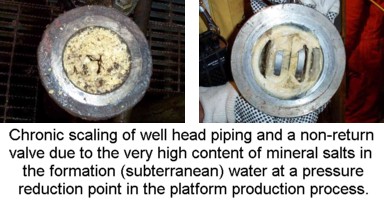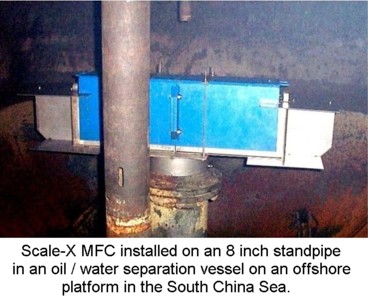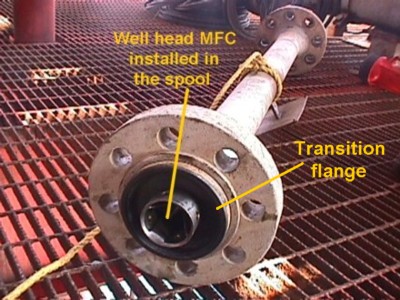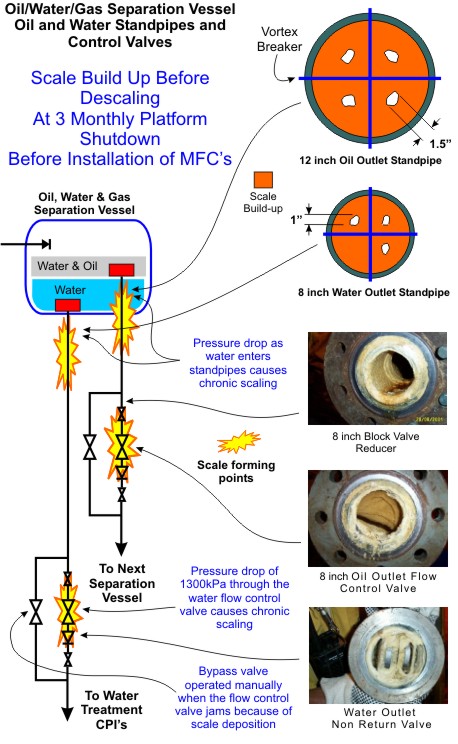|
|
|
||||||||||||||||||||||||
|
|
|||||||||||||||||||||||||
|
|
Scaling in valves, pumps, vessels, pipes and wells in oil and gas production process systems can consist of just the common inorganic salts such as calcium carbonate (calcite), dolomite, calcium sulfate (gypsum) and barite ( barium sulphate) or it can consist of the organic scales such as wax, paraffin and asphaltenes and/or any combination of all these plus other types of scales. These scales can be prevented using ScaleX Fluid Conditioning Technology.
The following
photographs are of scale build up from formation water
(subterranean water) in valves and pipes in a South China Sea
Petronas offshore platform
oil and water separation system. All of these
scales have a magnetic susceptibility of less than -0.25 and are
treatable by the Scale-X magnetic fluid conditioner.
For many Oil &
Gas Production systems, both offshore and land based, the fluid
dynamics need to be modified during transit through the MFC's to
bring the fluid parameters within the operating range required
for magnetic treatment of fluids to function. This change can be
achieved by use of specially designed ScaleX MFC's that
incorporate fluid velocity amplifiers and flow profilers.
Scale-X MFC's incorporating these functions, can be
strategically located at specific locations within the
production process. These units can be installed in
oil well
head systems immediately after
the well head Christmas tree, in process piping or within pressure vessels and
are installed at, or just prior to, identified scaling points.
They can also incorporate vortex breaker and inlet diffuser
functions. A typical offshore platform oil / water separation
process system may require
multiple stages of Scale-X MFC's as shown schematically.
Each of the MFCs are designed to treat the system up to the next
MFC and beyond, that is, the system is divided up into treatable
zones and the MFCs overlap into the next downstream zone.
Scaling in
these systems typically occurs as a consequence of a pressure
reduction, which, for example,
allows
dissolved carbon dioxide to come out of solution. The
most chronic scaling typically occurs after the pressure
reduction points at the wellhead choke valve and the standpipe
outlets of the oil / water separation vessels. Depending
on the CO2 saturation levels and progressive pressure reduction
within the process, it may be necessary to apply multiple stages
of ScaleX MFC's. Calcite, an inorganic mineral salt, is the
most common and most proliferous scale deposited in oil
production systems and is easily treated. Oil and gas production
systems also suffer from organic scaling of paraffin, wax and
asphaltenes.
As scale build up can be totally eliminated, there is no cumulative drop-off in production levels due to flow restrictions caused by progressive build up of scale formation in pipes, valves and vessel outlets. This results in a significant increase in production, which would normally return the cost of installation of the Scale-X MFC's many times over each year. Also, valves remain operational and separation vessel liquid levels and pressure do not need to be ramped up. All of these benefits were achieved by a Scale-X MFC's installation on a South China Sea offshore oil platform which experienced severe scaling problems from the "formation water (subterranean)" which required the platform to be shutdown and de-scaled every 3 months. |
|
Magnetically treated fluids eliminates scale formation on all
surfaces including valves, pumps and instrumentation as wells as
vessel and pipe walls. The successful elimination of scale
problems in control valves using Scale-X MFC's was the subject
of a
technical article published in Engineers Australia, Newsletter
of IE Aust. 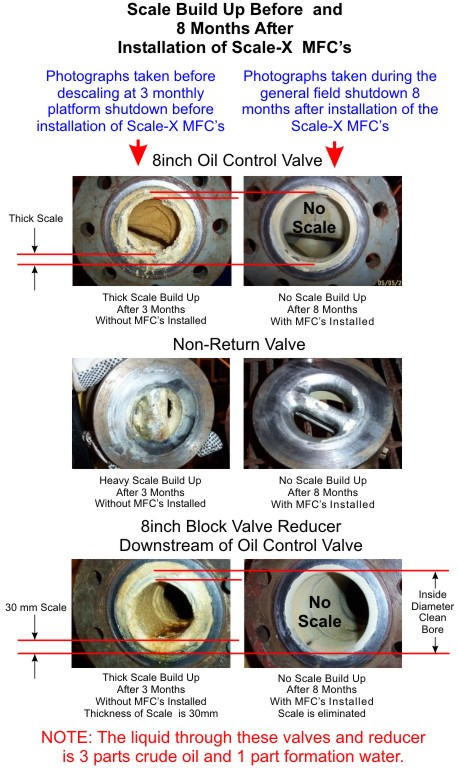
Problem No 1 Problem No 2 Dangerous chemical scale inhibitors are used to try to slow down the build up of scale with little success. These chemical are dangerous to personnel handling them. Scale-X eliminates the need for these chemicals. |
|
|
|

